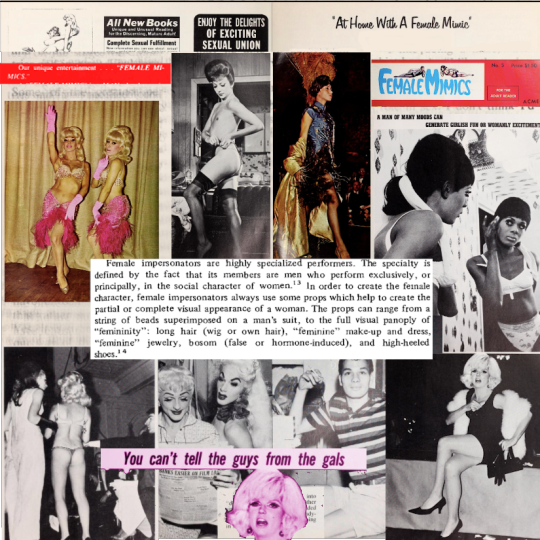#liiiiiitle bit leery of how this one will be received
Explore tagged Tumblr posts
Photo

[ID: a collage of photos. Top is the first inch of a two-page vintage magazine spread; left features an advertisement reading ‘Enjoy the delights of exciting sexual union’, right reads ‘At Home With A Female Mimic.’ Other collage photos include various femme-presenting people. Most of photos are black and white; all are vintage. At center is a large text block reading “Female impersonators are highly specialized performers. The specialty is defined by the fact that its members are men who perform exclusively, or principally, in the social character of women. In order to create the female character, female impersonators always use some props which help to create the partial or complete visual appearance of a woman. The props can range from a string of beads superimposed on a man’s suit, to the full visual panoply of “femininity”: long hair (wig or own hair), “feminine” make-up and dress, “feminine” jewelry, bosom (false or hormone-induced) and high-heeled shoes.” At the bottom is a pink-tinted caption reading ‘You can’t tell the guys from the gals’ attached to a head with makeup and earrings.]
In the course of research I was doing last year, I fell down a rabbit hole of historic magazines curated by the Digital Transgender Archive. I assembled this collage, among others, using screenshots from issues of the American magazine Female Mimics. All of these photos were published between 1963 and 1968. The central text is from Mother Camp: Female Impersonators in America, which was an anthropological ethnography--a professional academic study of a culture--done by Esther Newton in the same time period.
I was fascinated by the existence of a magazine celebrating these performers. In modern terms (to pull a bit of ahistoricism in the name of connection) the magazine features a blend of people we would identify as drag queens and others who would probably best be described as transfeminine. They didn’t refer to themselves that way, and not all of those pictured wanted to identify as women outside of their work--although several did! There were trans women who explored their identities or raised money for surgery by working as impersonators, and used this magazine as a platform to openly promote themselves (two of the featured trans performers were open enough about their histories that I could learn they went on to live long and successful lives: Marie-Pierre Pruvot and Jacqueline Dufresnoy). Everyone who appeared in this magazine, whether as professionals seeking to advertise themselves or readers writing in to let the editors know how affirming they found this magazine, sometimes including pictures of themselves, was engaging in a transgressive act.
The magazines themselves were an engrossing read, even if some elements seem in poor taste today. For one example, Female Mimics was sold as an adult magazine, which meant most of the advertisements were explicitly sexual and colored the tone of the whole magazine--I ended up making another entire collage of just that aspect of it. For another, it’s very much an expression of 60s politics in other ways, with a 50/50 chance of finding the word ‘exotic’ applied to any featured performer of color. On the whole, it was a really excellent reminder that the past is neither a wonderland nor a wasteland of queer history, of people transgressing the boundaries of sexuality and gender.
There is extensive debate today on the nature of drag, especially drag where people who otherwise identify as men dress as women, and whether or not such drag is transphobic. I wanted to explore what that conversation looked like decades before the word “transgender” was coined and codified in various ways, and try to understand how gender non-conforming people with different needs and identification shared the space of this magazine. These magazines formed a network of affinity and recognition and validation for many people in an era that was often as hostile towards gender non-conformity as our own can be. I wanted to honor that, and make something that captured the nuance that I see as the beauty of queer and trans history.
#queer history#thesis or death#trans history#historyish#female mimics#i might post the other collages#liiiiiitle bit leery of how this one will be received
36 notes
·
View notes